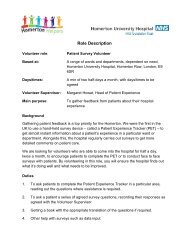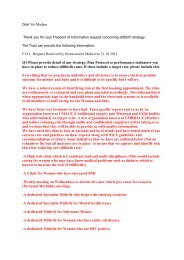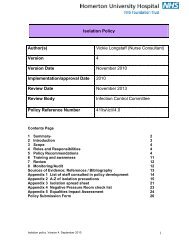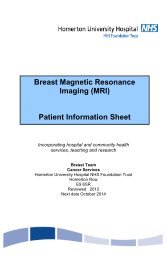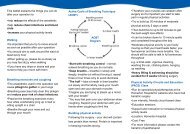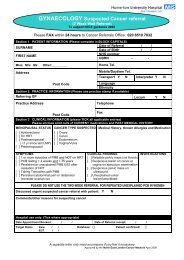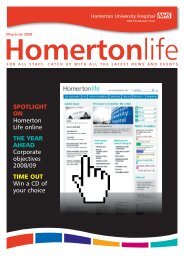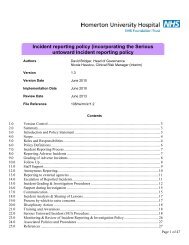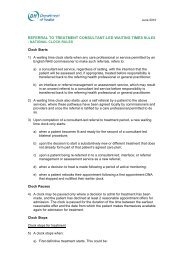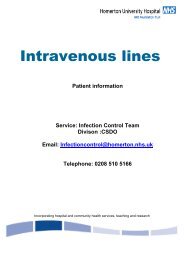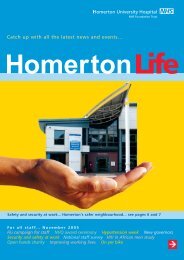Magnetic Resonance Imaging (MRI) of the Breast - Homerton ...
Magnetic Resonance Imaging (MRI) of the Breast - Homerton ...
Magnetic Resonance Imaging (MRI) of the Breast - Homerton ...
Create successful ePaper yourself
Turn your PDF publications into a flip-book with our unique Google optimized e-Paper software.
<strong>Magnetic</strong> <strong>Resonance</strong> <strong>Imaging</strong> (<strong>MRI</strong>) <strong>of</strong> <strong>the</strong> <strong>Breast</strong>Patient Information SheetWhat is an <strong>MRI</strong> <strong>of</strong> <strong>the</strong> breast?<strong>MRI</strong> stands for <strong>Magnetic</strong> <strong>Resonance</strong> <strong>Imaging</strong>. An <strong>MRI</strong> scan is an investigationthat produces pictures <strong>of</strong> <strong>the</strong> inside <strong>of</strong> <strong>the</strong> body or such as <strong>the</strong> breast. Themachine which takes <strong>the</strong> pictures is a large tube shaped magnet about four feetlong, linked to an advance computer. The whole body is inserted into <strong>the</strong>magnetic tube even if only part <strong>of</strong> it is being scanned. Unlike an x-ray, an <strong>MRI</strong>does not use radiation to do this.An <strong>MRI</strong> <strong>of</strong> <strong>the</strong> breast produces detailed images <strong>of</strong> <strong>the</strong> breast from side to side,top to bottom, and front to back. These images are <strong>the</strong>n interpreted by <strong>the</strong>radiologist.Why is <strong>Breast</strong> <strong>MRI</strong> used?• To evaluate breast implants for leaks or ruptures.• To assess abnormal areas that are seen on a mammogram• To monitor and check tumour shrinkage during chemo<strong>the</strong>rapy treatment.• After breast cancer is diagnosed to see <strong>the</strong> size <strong>of</strong> <strong>the</strong> tumour.• Sometimes used to image dense breast tissue, especially in youngerwomen.• Viewing any breast abnormalities that can be felt but are not seen on:-1. Mammogram2. Utrasound scan3. After breast surgery4. After radio<strong>the</strong>rapy<strong>MRI</strong> scans along with ultrasound and mammograms can find cancers early,when <strong>the</strong>y are very small and easier to treat. <strong>MRI</strong> is better at finding multiplesites <strong>of</strong> breast cancer in <strong>the</strong> same breast. Mammography is <strong>of</strong>ten better at findingsmall calcifications that are linked with non-invasive cancers. This means thatboth types <strong>of</strong> screening are useful.
<strong>Breast</strong> <strong>MRI</strong> is not used for a routine breast cancer screening, but clinical trials(research studies) are being performed to see if <strong>MRI</strong> is valuable for screeningcertain women, such as young women with a high risk <strong>of</strong> breast cancer.<strong>MRI</strong> cannot always accurately distinguish between cancer and non-cancerousbreast conditions.Where is <strong>MRI</strong> scan performed?<strong>Breast</strong> <strong>MRI</strong> is a specialised investigation; we do not <strong>of</strong>fer this service at<strong>Homerton</strong> University Hospital Trust. Our patients are referred to St.Bartholomew’s for <strong>the</strong>ir <strong>MRI</strong> breast scan.You will receive an appointment from St. Bartholomew’s University Hospital NHSTrust for your <strong>MRI</strong> scan. Along with your appointment letter <strong>the</strong>y will also sendyou details <strong>of</strong> <strong>the</strong> x-ray (radiology) department.The scan is usually done as an outpatient procedure, which means that you cango home after your tests. During <strong>the</strong> scan it is important to lie still and brea<strong>the</strong>normally; you will be able to communicate with <strong>the</strong> technologist over an intercom.Who can have an <strong>MRI</strong> Scan?In some cases you may not be able to have <strong>the</strong> <strong>MRI</strong> test done.Before going for <strong>the</strong> magnetic resonance imaging (<strong>MRI</strong>) <strong>of</strong> your breast, informyour health pr<strong>of</strong>essional and <strong>the</strong> radiologist if you:• Have a pacemaker, artificial limb, any metal pins or metal fragments inyour body (especially in <strong>the</strong> eyes), metal heart valves, metal clips in yourbrain, metal implants in your ear, tattooed eyeliner or metallic-basedtattoos, or any o<strong>the</strong>r implanted or pros<strong>the</strong>tic medical device (such as amedication infusion pump). Also, inform your health pr<strong>of</strong>essional if youhave worked around metal or if you have recently had surgery on a bloodvessel.• You are pregnant or breast feeding unless <strong>the</strong>re are specialcircumstances.• If you have a known allergy to <strong>the</strong> contrast (dye) used for <strong>MRI</strong>.• If you have o<strong>the</strong>r health conditions, such as serious kidney problems orsickle cell anemia, that may prevent you from having an <strong>MRI</strong> usingcontrast material.When I arrive?You will be shown to a private cubicle where you will be asked to take <strong>of</strong>f yourouter garments and remove jewellery or any o<strong>the</strong>r metallic items you will have on




